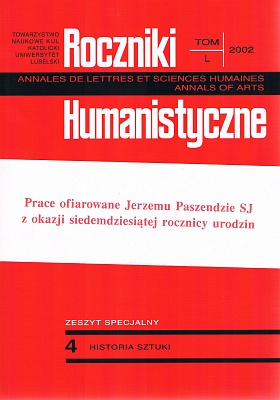The Second Jesuit School in Poznań
Abstract
In principle the Poznań Jesuit college was established in the 16th century. In the next centuries all the buildings were replaced. After construction of the new church was started also building of the new school was begun. The buildings belonging to the first school were included in the structure of the old college, along with which they were pulled down in the first half of the 18th century. The former second Jesuit school that has existed till this day occupies half of the quarter situated north of the post-Jesuit complex. It is a three-wing building with a picturesque octagonal yard in the middle. In the oldest literature it is dated to the beginning of the 18th century. Studies conducted after the war showed that it was built as early as the 17th century and then it was extended several times.
The collected material allows the constatation that the school was built in the place where a medieval bath had been. The construction was supervised from 1683 by the then rector of the college, an outstanding architect-theorist Bartłomiej Nataniel Wa˛sowski. It was a narrow building spread along Gołębia Street, with the entrance probably from Świętosławska Street. It had two storeys, its elevations were articulated with Tuscan pilasters in the grand order. It was used from 1690; after a few years it was extended by building two classrooms, probably by Jan Catenazzi. They adjoined the building on the east side and reached Klasztorna Street. Next the realties adjoining it from the north were added. The first one was bought in 1720. Further, the three parcels that had belonged to the Jesuits earlier were joined after the houses on them were repaired in the years 1727-1730. Extending the school building involved repeating on the elevations the articulation that was on the older segments of the school. In the years 1759-1766 the school was rebuilt according to the design by the then provincial, an outstanding architect, Franciszek Koźmiński. The main element of the reconstruction was the yard, modelled after Roman architecture (Sapienza, the little yard at S. Carlo alle Quatro Fontane), with two tiers of archades that had a representative flight of stairs on the north side. Apart from classrooms in the rebuilt school there was also a chapel on the ground floor of the eastern wing and over it a spacious auditorium. Also the portal in the middle of the southern wing that has not been preserved to our times came from that time.
After the Jesuit order was suppressed and Poznań was annexed to Prussia the building became property of the parish. It was used as a store-house, town school (it was then when a low first floor was added), next as a tenement house and school of decoratory arts. During the war it was seriously damaged, reconstructed in 1954-1957, it houses a ballet school now.
Copyright (c) 2002 Roczniki Humanistyczne

This work is licensed under a Creative Commons Attribution-NonCommercial-NoDerivatives 4.0 International License.





